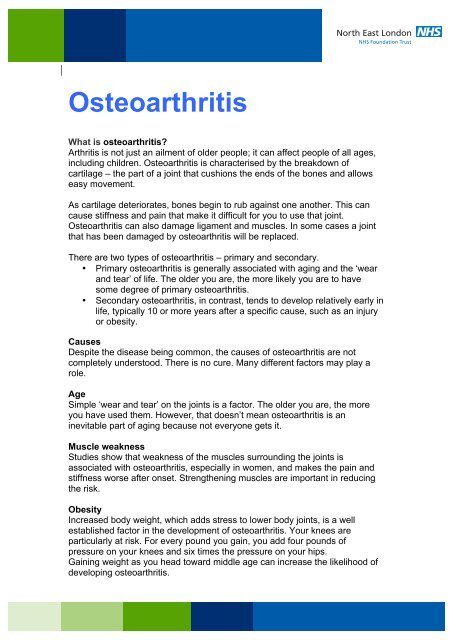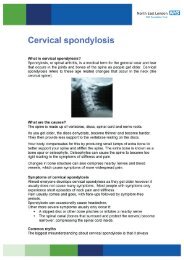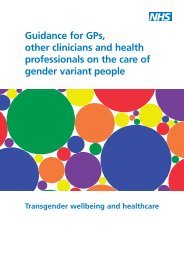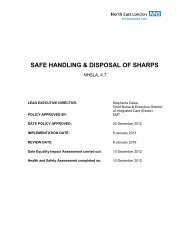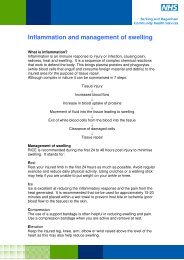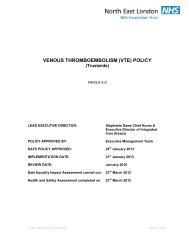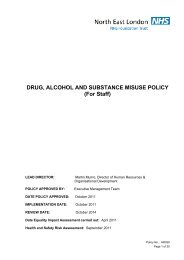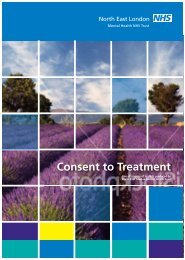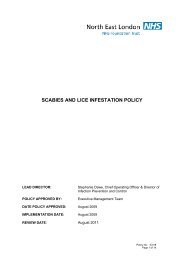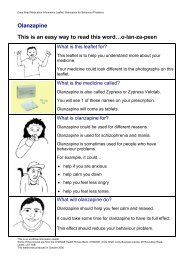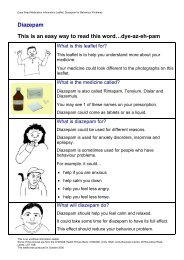Osteoarthritis information leaflet
Osteoarthritis information leaflet
Osteoarthritis information leaflet
Create successful ePaper yourself
Turn your PDF publications into a flip-book with our unique Google optimized e-Paper software.
<strong>Osteoarthritis</strong><br />
What is osteoarthritis?<br />
Arthritis is not just an ailment of older people; it can affect people of all ages,<br />
including children. <strong>Osteoarthritis</strong> is characterised by the breakdown of<br />
cartilage – the part of a joint that cushions the ends of the bones and allows<br />
easy movement.<br />
As cartilage deteriorates, bones begin to rub against one another. This can<br />
cause stiffness and pain that make it difficult for you to use that joint.<br />
<strong>Osteoarthritis</strong> can also damage ligament and muscles. In some cases a joint<br />
that has been damaged by osteoarthritis will be replaced.<br />
There are two types of osteoarthritis – primary and secondary.<br />
• Primary osteoarthritis is generally associated with aging and the ‘wear<br />
and tear’ of life. The older you are, the more likely you are to have<br />
some degree of primary osteoarthritis.<br />
• Secondary osteoarthritis, in contrast, tends to develop relatively early in<br />
life, typically 10 or more years after a specific cause, such as an injury<br />
or obesity.<br />
Causes<br />
Despite the disease being common, the causes of osteoarthritis are not<br />
completely understood. There is no cure. Many different factors may play a<br />
role.<br />
Age<br />
Simple ‘wear and tear’ on the joints is a factor. The older you are, the more<br />
you have used them. However, that doesn’t mean osteoarthritis is an<br />
inevitable part of aging because not everyone gets it.<br />
Muscle weakness<br />
Studies show that weakness of the muscles surrounding the joints is<br />
associated with osteoarthritis, especially in women, and makes the pain and<br />
stiffness worse after onset. Strengthening muscles are important in reducing<br />
the risk.<br />
Obesity<br />
Increased body weight, which adds stress to lower body joints, is a well<br />
established factor in the development of osteoarthritis. Your knees are<br />
particularly at risk. For every pound you gain, you add four pounds of<br />
pressure on your knees and six times the pressure on your hips.<br />
Gaining weight as you head toward middle age can increase the likelihood of<br />
developing osteoarthritis.<br />
1
Recent research suggests that excess body fat produces chemicals that travel<br />
throughout the body and cause joint damage. Therefore obesity could affect<br />
joints in this way as well as overloading joints.<br />
Injury or overuse<br />
Athletes and people whose jobs involve repetitive motion (landscaping, typing<br />
or operating machinery), have a higher risk of developing osteoarthritis due to<br />
injury and increased stress on certain joints. It can also appear in joints<br />
affected by previous bone fractures and soft tissue injuries and surgery.<br />
Genetics or heredity<br />
Inherited bone abnormalities that affect joint shape or stability or defects that<br />
cause cartilage to form abnormally can lead to osteoarthritis. Having these<br />
traits, however, doesn’t mean you’ll develop osteoarthritis. It just means that<br />
you and your doctor should monitor signs and symptoms.<br />
Diagnosis<br />
A diagnosis will be made on the basis of your symptoms, a physical<br />
examination and medical tests.<br />
Your doctor or physiotherapist will:<br />
• check for any bony swellings and creaking joints, as well as looking out<br />
for any restricted movement, joint tenderness or instability<br />
You may have:<br />
• a blood test to rule out other kinds of arthritis<br />
• X-rays to confirm osteoarthritis and show the joint changes<br />
If you are diagnosed with osteoarthritis, your GP will be your main contact for<br />
managing your condition.<br />
You may be referred to a physiotherapist for joint care advice. If your arthritis<br />
is severe, the GP can refer you to a rheumatologist, orthopaedic surgeon or<br />
pain specialist.<br />
The joints that are most commonly affected are the hips, knees and hands.<br />
Symptoms<br />
The main symptoms of osteoarthritis are:<br />
• pain, especially when doing load-bearing activities, such as walking<br />
• short-lived stiffness in the morning, which improves in 30 minutes or<br />
less when you start to move<br />
• difficulty moving your affected joints or doing certain activities<br />
However, in some cases of osteoarthritis you may not have any symptoms at<br />
all, as the pain can come in episodes. Often, you will only experience<br />
symptoms in one joint or a few joints at any one time. Your symptoms may<br />
also develop slowly. Other features may include:<br />
• joint tenderness<br />
2
• increased pain and stiffness when you have not moved your joints for a<br />
while<br />
• joints appearing slightly larger or more 'knobbly' than usual<br />
• a grating or crackling sound or sensation in your joints<br />
• limited range of movement in your joints<br />
• weakness and muscle wasting (loss of muscle bulk)<br />
Treatment<br />
Exercise and lifestyle changes<br />
Exercise is the most important treatment for people with osteoarthritis,<br />
whatever your age or level of fitness. Your physical activity should include a<br />
combination of exercises to strengthen your muscles and exercises to<br />
improve your general fitness.<br />
Being overweight or obese makes osteoarthritis worse. The extra weight puts<br />
more strain on damaged joints, which have a reduced ability to repair<br />
themselves. Joints in the lower limbs, which carry your weight, are under<br />
particular stress if you are overweight or obese.<br />
Physiotherapy<br />
A physiotherapist can mobilise joints and soft tissue as well as prescribe<br />
correct exercises and pain relieving resting positions.<br />
Pain relief<br />
Correct pain medication or the use of a TENs machine can be beneficial. You<br />
should seek advice from your doctor or physiotherapist.<br />
Surgery<br />
In more severe cases when the quality of your life is being affected, surgery<br />
may be implicated. This is always a last resort.<br />
3


